Shibori is a Japanese term for methods of dyeing cloth by binding, stitching, folding, twisting, and compressing. In Japan, the earliest known example of cloth dyed with the shibori technique dates back to the 8th century where indigo was the main dye used. We were immediately inspired by this fascinating technique, it’s history and beauty. After much research, we decided to tackle 3 techniques of Shibori dyeing with an Indigo Tie Dye Kit, a few old white shirts and scarves, and several household items.
1. Arashi (Japanese for “storm”) shibori a pole-wrapping technique. The cloth is wrapped on a diagonal around a pole or cylindrical object (we used old PVC and copper piping) and then tightly bound by wrapping thread or wire up and down the pole. Next, the cloth is scrunched down on the pole. The patterns are on a diagonal in arashi shibori which suggests the rain from a heavy storm. (Click images to enlarge)
2. Kumo shibori is a twist and bind resist technique. This technique involves wrapping sections of the cloth over a found object, usually small stones or pebbles. Then the cloth is bound in very close sections with rubber bands. The result is a very specific circular spider-like design.
3. Itajime shibori is a shape-resist technique. The cloth is folded like an accordion and sandwiched between two pieces of wood or any flat shaped object, which are held in place with string or rubber bands. The shapes prevent the dye from penetrating the fabric they cover and give an endless variety of patterns depending on the fold, binding object and placement of rubber bands.
We’re ready to dye!
Following the dye preparation directions from the Indigo Tie Dye Kit were easy; first rinse your fabric with water, dip in the indigo vat that was premixed before binding the fabric, let it oxidize and dry for 20 minutes and then repeat the steps for darker shades of indigo. Be aware that the color is much darker when wet and will fade after rinsing.
Rinse the fabric with water and undo the bindings to reveal the surprising creations.
Our patterns revealed: Arashi, Kumo and Itajime. The possibilities are endless–try varying and even combining the techniques to see what you are able to create. Your indigo dye vat will keep for several days and dye at least 15 pieces of clothing.
Our Shibori dyed goodies!!! We can’t wait to dye more and even try our hand at recreating this gorgeous Suno dress.
(top image Shibori master Motohiko Katano and Japanese Shibori fabric, rest of the images by Honestly…WTF)

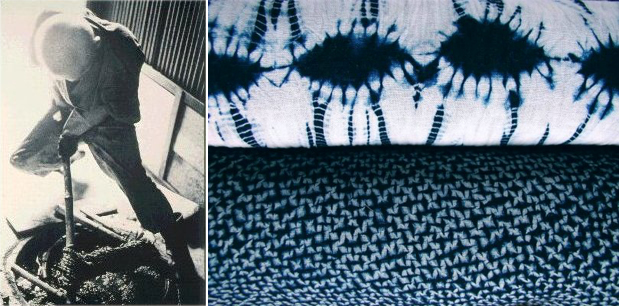






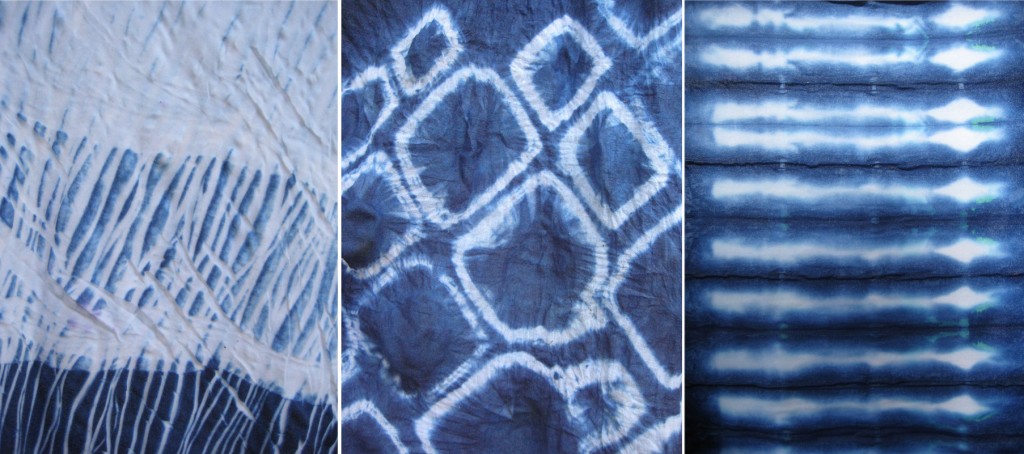
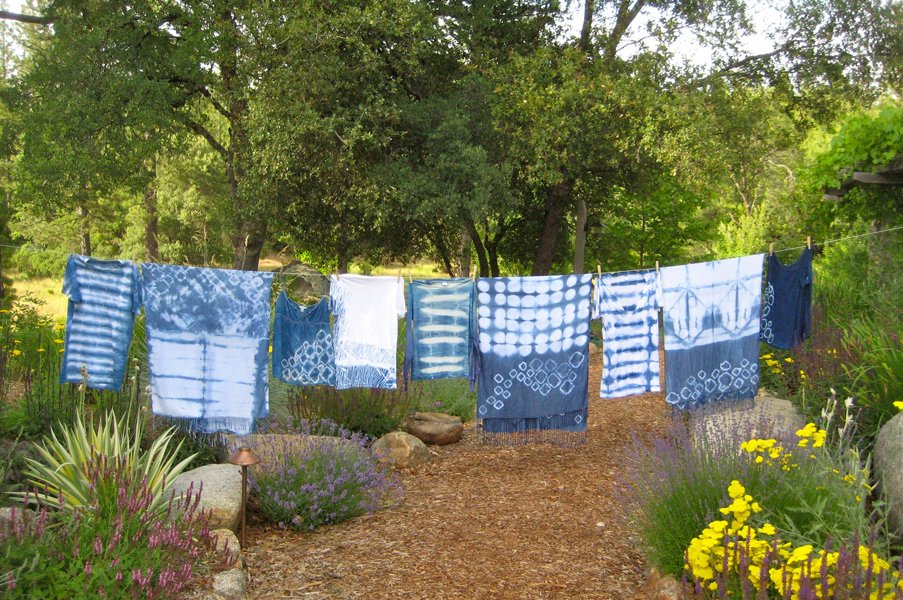

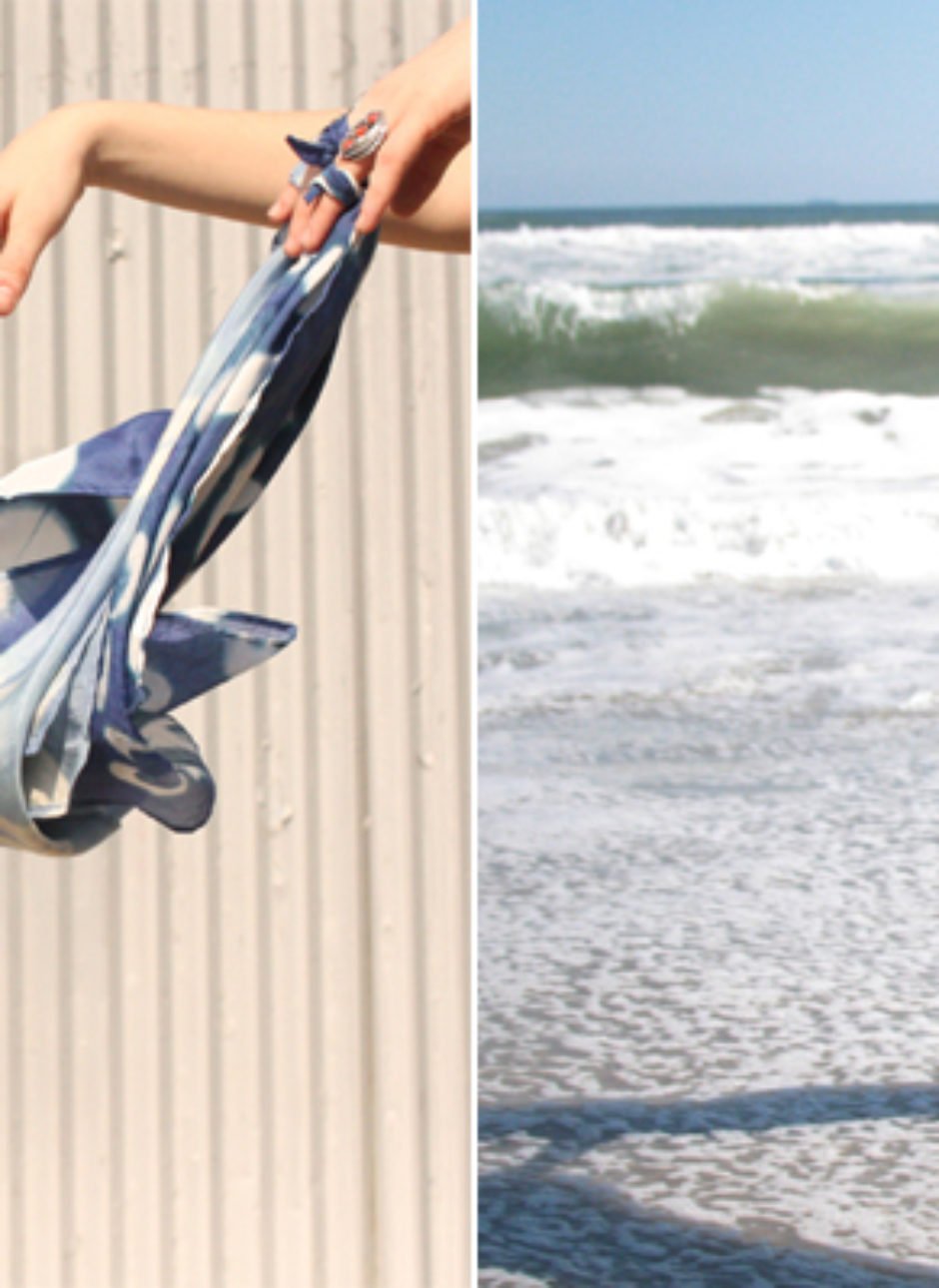
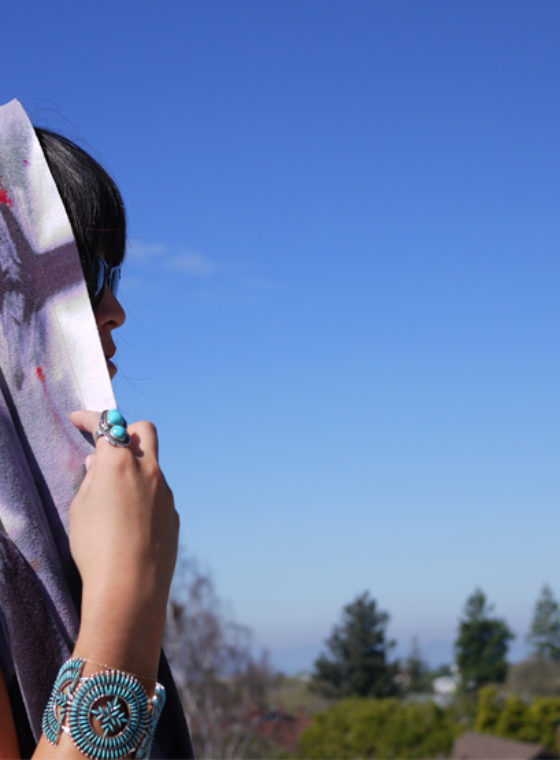
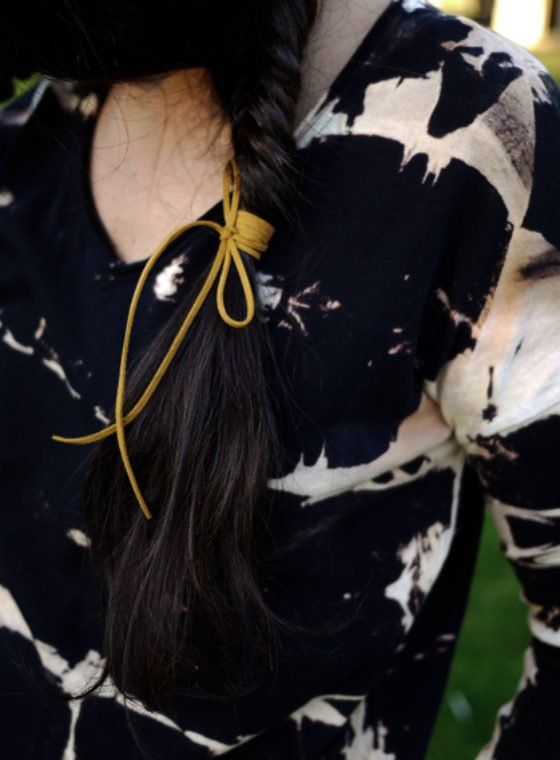
Erica, that was so much fun, what’s next? I have gotten a ton of compliments on my scarf, best part is I get to say I made it!!!!!
The stones make a great bubble effect!
I’m totally going to try this. I have a caftan that I bought the other day specifically to dye it.
M so dyin’ to try this I loved Shibori but can’t wait to test out the rest!
This looks awesome! Thanks for sharing the techniques and interesting facts.
How did you get the white circle effect? Not the ones outlined in white with a blue center but fully white. It’s on the top of the piece 4th from the right. I’m not really seeing how it was done in the demonstration of the techniques.
Katie, the white circle effect was done using the Itajime shape-resist technique. So instead of using rectangular wooden pieces to bind, we used circular shapes (in this case, canning jar lids). And instead of using rubber bands to bind the fabric between the “shapes” we used clamps from the tool shed (which you can find at the hardware store). Hope that answers your questions!
OMG! I just bought these tie dye leggings…and am in LOVE with tie dye..and they’re on sale!
http://www.shopbop.com/lakota-leggings-leyendecker/vp/v=1/845524441866251.htm?folderID=2534374302046710&fm=browse-brand-shopbysize-viewall
Thank you SO MUCH for this! i will be using this to guide my dying loving HEART!!!
-Tiffany of Love, Mama
This is amazing! What technique would I have to use to achieve the effect seen in the fabric at the bottom of the very first image? I didn’t even realise you could do that with tie dye!
Hi there- Loved this post and was so inspired I had to do it for myself! Am loving the results! I just have to make sure that the whole family isn’t walking out of the house with their new shibori t-shirt on, lol.
Just wondering if you had any tips about the disposal of the dye when finished with it…
I am so happy to have stumbled upon your Shibori project, I have been scouring the internet for info about Shibori all weekend after seeing it for the first time this weekend at the American Craft Council in SF, check the woman’s fantastic work out. Her is a link to her site, the sculptural and texture sections are truly amazing (although the images barely did her work justice)
http://www.wendysmithwood.com/#s=0&mi=1&pt=0&pi=1&p=-1&a=0&at=0
If anyone has and info about the adding of texture in Shibori I would love to hear about it. thanks
Fantastica tu pagina, adoro esta tecnica.
If yall figure out how to dye clothes like the suno dress let us know!! I have a shirt I am “dying” to dye that way! 🙂
Ryan, the Suno dress was done using the Arashi method mentioned above! Let us know how it turns out! xx
loving this. going to try the arashi technique with the bleach tie-dye you guys mentioned in today’s post. will let you guys know how it turns out.
http://nomadic-d.blogspot.com/
Very good post thanks for sharing
ok, tried it. failed but love the results anyway. check it out here:
http://nomadic-d.blogspot.com/2011/03/reverse-tie-dye-surprise.html
your bad womp womp
Nomadic D, I think your shirt turned out cool! I love that color!
Erica, Lauren, in the middle picts, the dying shots, it looks like you have two pieces that were braided?? how did that turn out? are they in the finished projects pictures?
I’m LOVING all your DIY’s btw!
Where did you guys get such deep v necks? lol
@lolwut American Apparel!
This technique of dying clothes is similar to the procedure used in India called Bandhani
AWESOME! I love shibori and your fabrics turned out so beautifully!
Just did some experimenting! http://sarahcrump.tumblr.com/post/8109714707/fun-with-bleach-tie-dye-i-used-this-tutorial-for Thanks for the tutorial!
how do you do the top part of the 8th shirt?
@Erin I’m not sure what the 8th shirt is?
sorry the 8th piece on the picture of the clothesline. the one with the 2 hexagon-like shapes on the top and the itajime stone technique on the bottom
Awesome!
how did you do the pattern for the shirt the third in from the right on the clothesline?
I just fell in love with the Anthropologie Shibori bedding, but not the price tag! Thank you for this tutorial – my crush will be mine!
Fantastica tu pagina, adoro esta tecnica.
urdu poetry
These are gorgeous! I’m going to have to try this now. ^_^
I just tried this myself – thanks for the tutorial! It was so much fun, I imagine I will do it again and again.
The pictures from my own project are here:
http://missiontobywater.blogspot.com/2011/10/shibori-all-day-and-night.html
Awesome! Great Art Work nice sharing …..
And shibari means entirely TOTALLY different. Anyway, this is an awesome DIY.
I like your work is beautiful.
congratulations
bye
Josefina
tijerasycuchara.wordpress.com
oh wow this is so amazing. I am student teaching (art ed major) this semester (start in a few weeks). I can not WAIT to chat with my co-op teacher about this! It’ll be a great way to teach wiggle in non-western art…. it’s high school and I think my kids will like it! fingers crossed!!
this DIY is epic!
omg I just discovered this site and I am overwhelmed by the number of diy projects I now want to do
Wow!!!, I want to start doing that now!!!, how artistic and beautiful!!, thank you for the post!!!!
Me encanta hacer todas estas técnicas de teñido. Es un trabajo original porque cada trabajo es una obra de arte.
Thanks so much for the inspiration guys. I just had a go and it was ace! Now begging everyone I know for any more white garments! Pics here: http://katysordinarydays.blogspot.co.uk/2012/07/how-to-shibori-tie-dye.html
Me and my best friend tried out the one with the rocks, and we absolutely love our new shirts! Thanks!
Love it!! 🙂
Super-freakin awesome!
So many amazing projects, so little time. I love these effects and the indigo is beautiful!
Nice Good..
Adorei seu trabalho. Estou pesquisando sobre o Tie Dye e Shibori. Estou aprendendo as técnicas para trabalhar na produção de camisetas para vender. Muito legal. Como os desenhos ficam com o efeito de quadrado? Abraços.
The new tie dye. I love it.
Having tried and failed to do arashi shibori last summer I am very impressed with your results, and feel ready to try again. Thanks.
really nice and good idea.
Very Good Site to know and learn about tie and Die Technique. Good stuff and learnt a lot from here . Thank you for posting this post. Looking forward to have more of it and keep reading it.
Best Regards
Paromita
http://fashionstudio-urbanpurple.blogspot.com
I like it very much! 😀 😀 😀
It is my favourite site.:)
I actually get interrupted by those beautiful shrubs. 🙂
I blog quite often and I seriously thank you for your information.
Your article has really peaked my interest. I’m going to book mark your site and keep checking for new details about once a week. I opted in for your RSS feed as well.
i used this post as a how-to to make my own shibori dye fabric. i made a pretty quilt out of it and just got it back from the quilter… couldn’t have done it without you. thanks for all the useful information!
Awesome! What a great idea.. i like it.
awesome effect !
Shibori. Didn’t know they have such a nice term for it. Did this skill started from Japan? They have such a long history! Nice info btw.
wow I returned to uni today ready for year 2 of my textiles degree and until now was lacking inspiration and motivation for my print project until I came across this site, so shibori it will be for me. so thankyou honestlywtf.com
love this tip to DIY the Shibori. So unique. I never saw the second one do it.
Hello – this is absolutely wonderful! Just wondering if you might be able to post some images of the circle/Itajime shape-resist technique that Katie was referring to as I am head over heels for those dots!! thanks so much! Josie
You dod an awesome job! just beautiful. Love you guys!!
did 😉
The white circles are made by folding fabric around canning lids and then binding them together. This colors the outside of the fabric and not what is bound with the canning jar lids.
i really like the art and suclpture.
this is so beautiful…now what with Urban Outfitter’s noodle collection selling blankets for hundreds of dollars, you could just make it at home! So excited to try this!
Very interesting and excellent post you given to me.
Realy amazing technique! Looks great!
Nice…work
It’s cool how some cultures share things without (to my knowledge) actual contact. When I see those fabrics, I think of home, southwest Nigeria, Our indigo dyed fabric is called adire. I remember a class years in primary school where we were shown how to do the kumo technique and it was fun to see the results.
I used some Yoruba adire to make this top http://www.peppermintandpaisley.com/2013/07/29/adire-peplum-top/
Thanks so much for the article.Really looking forward to read more. Really Cool.
Wondering what material you used for the 2nd 6th and 8th items across on the washing line? And where you got that material from? Cheers
pathak
amitpathak.pathak5@gmail.com
Pretty part of content. I simply stumbled upon your web site and
in accession capital to say that I acquire actually enjoyed account your blog posts.
Anyway I will be subscribing to your augment or even I fulfillment you get right
of entry to consistently fast.
I constantly spent my half an hour to read this web site’s content every day along with a mug of coffee.
I luv the shibori! The very 1st pic on the left, that has 3 layers of dye from white to blue. I don’t see a name for it? I love the wrinkled look, and varying colors.
It’s cool how some cultures share things without (to my knowledge) actual contact. When I see those fabrics, I think of home, southwest Nigeria, Our indigo dyed fabric is called adire. I remember a class years in primary school where we were shown how to do the kumo technique and it was fun to see the results.
Honestly wft how did you make this stuff I can’t afford the die. Sorry dye
Wow !! Such a Great information on Shibori . As an Indian Girl i knew some thing today about this Japanese art . Thank you so much for such a nice information .
Regards
Amanda
What a right that is right! Well, you described it, I like it!
http://www.mayfair-escorts.net
It looks very unusual! Have you tried to make the same T-shirts but in different colours? I mean like to mix more than two colours…? But the idea is truly great, my children will probably like doing this handmade at weekend.
Really fantastic technique and good idea and i love it.. thank you for sharing it……
you have got a different idea about applying DYE to clothes…
the way you apply dye is really amazing… please share more ideas…
https://www.smcreation.co/wholesale/kurtis/
I can’t wait to do this! Thank you so much for this article and how to’s. I went to China and haggled for one of these in the markets. I love it so much, that indigo is my favorite color. I am so excited to try my hand at it. <3
Beautifully amazing! Gorgeous I am going to give it a try this summer. I would like to share too,.
The stones make a great bubble effect!
Thanks for sharing with us. This looks awesome!
This looks awesome! Thanks for sharing the techniques and interesting facts.
Thanks for sharing with us kimora sarees .
thanks for sharing great informtion.
This looks awesome! Thanks for sharing the techniques and interesting facts.
Nice post..
amazing post i really like it thanks for sharing with us